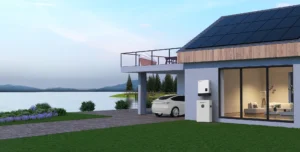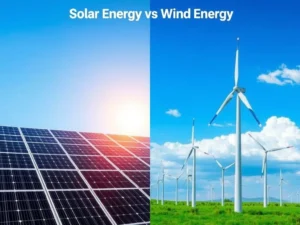The rise of pollution and carbon emissions has diminished the ozone layer and caused global warming. But now businesses and eco-lovers are moving toward sustainable and renewable energy resources.
Here come the two robust solutions—Solar energy and Wind Energy. But which one is the better solution among both? If you have these questions popping up in your mind, don’t worry.
This guide is where we will dig up the best energy source for you.
What is solar energy?

Solar energy refers to the energy generation process from the solar system and usage in the home or commercial sectors.
How do you generate this energy? It is simple. Photovoltaic cells trap the sunlight and convert it into an electrical form. However, the energy generation is in the DC form. Solar Inverters transform this DC into AC for use in home appliances.
The necessary components to generate solar energy and storage include:
- Solar panels feature photovoltaic cells that capture sunlight.
- Depending on your type, inverters change the energy format from DC to AC and AC to DC.
- Batteries help store energy and are used as a backup when energy sources are exhausted.
What is wind energy?
Wind Energy. The term defines it all. The heavy wind can help generate energy. Are you wondering how?
Quick and easy. The turbines can transform the kinetic energy into electricity through the various tools and devices installed to generate the power.
You must know the following components to understand wind energy.
- Turbines are like the fans on which the wind acts and moves their blades. It creates the kinetic energy
- Rotors spin the generators with their kinetic energy generated.
- Generators are the primary power sources that supply the energy generated from the wind sources.
Wind energy generates more power if more wind is available for power generation.
Solar energy vs Wind Energy: Differences

Solar energy and wind energy can both be the best sources for energy generation. But they are not suitable for all the cases. For instance, how can you even think of the wind energy in the home installation? It is impossible to deploy such a diverse system.
Do you want to know the differences between both power sources? Take a look.
Energy source
Energy sources can be a defining movement. It also defines how large-scale energy deployment can be.
Sunlight is the primary source of solar energy. Solar panels help produce the power and get the powerful source.
Wind energy comes from the high-power wind. It turns the turbine blades and generates kinetic energy. This kinetic energy does the magic of electricity generation and easy power transmission.
Availability and reliability
Availability can define energy production. Think about a solar system without a battery storage system. It will generate power only when the sun is around. You’ll have to wait for the sun to generate energy. So, understanding the availability of energy can change your decision.
Solar energy is available during sunlight. So, don’t consider it a 24/7 energy source. You have to spend extra bucks on the batteries for energy availability.
Conversely, wind energy is a 24/7 source—no tension of sunlight. You get a constant source of energy all day long.
Space requirement
How much space do you have? For a small home, you have less space. It is good if you have a farm with plenty of space. Both energy sources come with different requirements.
Solar energy requires less space. First of all, solar panels are compact in design compared to turbines. You can install them on the rooftops without relying on the open space.
For wind power, you can no longer generate energy without the open space. Turbines are heavyweight and oversized in size. They need the open space to let the wind run them.
Energy output
Energy output can be a decisive factor for the users. If you need high energy, you must select both sources.
Solar power is not very efficient. It can’t generate more energy than wind power per square meter. So, the energy output coming out of the solar panels is suitable for the home or minor scales.
For the large scales, you must lean toward the wind energy. It generates sufficient power and provides an endless energy source.
Environmental impact
Influence on the local creatures and environments can define a better energy source.
Solar energy is an eco-friendly source, but it impacts the environment on the disposal of solar panels. Large-scale installation can affect the local farms.
Wind energy has more impact on birds and other similar creations. The heavy wind can impact their flying patterns and disturb the environment.
Which energy type do I need?
After learning, opting for the right energy source is not difficult. However, let’s make the selection more straightforward for you by looking at the following points:
- How much energy do you need?
- What is your maximum?
- Do you have sufficient space to install the energy system?
- How compact and easy is the solution you need?
Indeed, you want an affordable and easy-to-install solution with reduced space requirements. Solar panels win as a source of solar energy. Their power generation is next-level while saving space. Moreover, they aren’t costly compared to wind energy.
You should opt for the solar systems if you want:
- Easy and comprehensive installation
- Cheaper energy
- Longevity
- Reduced price
Conclusion
Solar energy is undoubtedly the best solution in this case. It is cheaper, more practical, and generates high power. However, you must have the right brand partnerships for impactful energy installation.
Do you want the best solar solutions, such as inverters?
Don’t worry; LuxPowerTek is there to help you out. We have premium quality solar inverters that transform solar energy into AC for home usage. Check out the practical and affordable solar inverters now!

